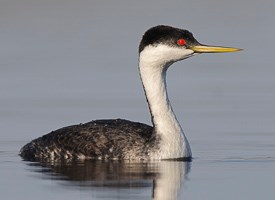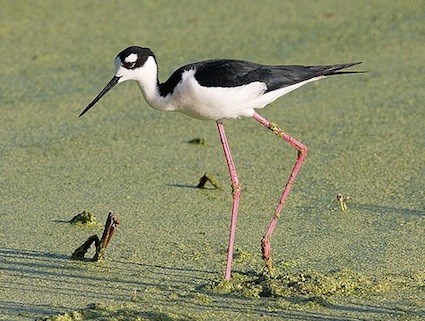 |
| Mountain view from Bear Lake National Wildlife Refuge, Idaho |
In the beginning of June, Dave and I took a two-week vacation out West. We flew into Salt Lake City where we rented a car which carried us approximately 2,000 miles through northeastern Utah, western Wyoming and Southern Idaho. I hope to post a few blogs that will highlight some of the wildlife we saw. I was going to post one blog on birds, but we saw so many that I will divide it into two posts. This post will focus on bird sightings in Utah and at the Bear Lake National Wildlife Refuge (NWR.) Traveling at the beginning of June was a perfect time to see a lot of different birds that were either migrating or, having reached their summer destination, were staying put to breed. I have realized that after our trip to South Dakota last year, and now this trip that I need to acquire a North American
Western Region field guide as many of the birds we saw would never be found in New England.
We were only in Utah for a little over a day, but I was still able to check off two new bird species. The first was an American Dipper, spotted along the Logan Canyon Byway. We stopped to walk along a path by the river and saw the Dipper within a few minutes. I knew right away what it was since we met a birdwatcher last year who was looking for them in Spearfish Canyon, South Dakota. This river and canyon here were very similar to Spearfish.
 |
| American Dipper (at left) dipping into the water in search of food |
The American dipper is a songbird, but is unique in that it catches most of its food in fast moving streams by walking or diving underwater. He was fascinating to watch.
The second species we saw was the White Pelican. I have always associated pelicans with the ocean, but they actually spend summers on inland waters. We saw these birds on Bear Lake, which is located in both the Utah and Idaho. We spent the night on the lake in Garden City, Utah and then drove north the next morning to the Bear Lake National Wildlife Refuge (NWR) just north of the lake in Idaho.We saw the pelicans in both states.
 |
| White Pelicans with Canada Geese at Bear Lake National Wildlife Refuge, Idaho |
|
White Pelicans are one of the largest birds in North America, with wing-spans up to nine-feet! Their large size is apparent in the photo above as the Canada Geese are dwarfed by them.
 |
| Idaho Birding Trail SE33 Bear Lake NWR |
Idaho has mapped
birding trails of the entire state. They also classify certain sites as "blue ribbon" sites. We were fortunate that unintentionally our travels took us by several "blue ribbon locations." The Bear Lake NWR is one of the ribbon locations site and it did not disappoint. Even before we turned onto the Refuge Entrance Road, there were different species of birds everywhere.
This long beaked bird below appears to be a Wilson's Snipe. The Cornell Lab's website states that they like to stand on fence posts which is what this one was doing.
 |
| Wilson's Snipe |
It was impossible to miss the bold color of the Yellow-Headed Blackbirds which were perched along the fences. They nest in the same habitat as red-winged blackbirds, but are larger and more dominant. Fossils of this bird have been found which date back 100,000 years.
 |
| Yellow-headed Blackbirds were common |
We had still not even arrived at the refuge entrance when we saw an eagle in a farm field. It was a juvenile bald eagle, perhaps in its second year.
 |
| Juvenile bald eagle with Magpies |
Later, while leaving the refuge and at approximately the same location, we thought we saw another eagle...
However, when it turned its head we could see that it was a turkey vulture. I'm not sure why a bald eagle brings a feeling of awe, but for many a turkey vulture brings a feeling of disgust. I personally think that they are attractive in their own right.
 |
| Turkey vultures have a bald red head |
Once we actually entered the refuge we started to see lots of waterbirds. Most were first time sightings for me. Below is what I believe to be a male and female Lesser Scaup. The colorings are a little different than what I have seen on-line, but the shape and description seem to match. Please correct me if I am wrong.
 |
| Lesser Scaup pair? |
The American coot, although resembling a duck when swimming, does not have webbed feet and needs to "run" across water before taking flight.
Its white bill is unmistakable.
 |
| American Coot |
 |
| Western Grebe |
The Western Grebe was one of the first birds we saw in the refuge and they were common throughout. Their long neck and flattish topped head, reminded me of a serpent. They have a very elaborate courting dance which we did not get to witness.
As you can tell, many of the birds we saw were at a distance, so it was difficult to get a good picture, but due to the unique color of a particular breed, identification was not difficult - like with the Cinnamon Teal below.
 |
| Stunning Orange Teal |

 |
| Rudy Duck |
Although it is difficult to see in my photo on the left, the blue beak of the Ruddy duck made it easy to identify. Another distinguishing feature of this bird is how its tail sticks straight up in the air.
One particular wetland area was filled with hundreds of birds - most we could not identify, but these Black-necked Stilts were easy to recognize with their red legs and a white crescent over their eye.
 |
| Black-necked Stilts in wetlands |
Note: smaller photos copied from Allaboutbirds.org
 |
| I need help with the identification of this bird? |
I could have stayed in the NWR all day, but alas, we needed to continue on our journey north to Wyoming and the Grand Tetons and Yellowstone National Parks. As we exited the refuge, the bird sightings were topped off with a close-up look at an inquisitive badger.
 |
| This Badger came out from hiding to check out our car. |

























